#Pleistocene era
Text
A Crucial Bottleneck in Human Evolution
A new study published in Science provides fascinating insights into a pivotal period in human evolution when our species teetered on the brink of extinction.
Researchers from China, Italy, and the U.S. utilized a novel genomic analysis technique called Fast Infinitesimal Time Coalescent Process (FitCoal) to examine this crucial population bottleneck.
FitCoal calculates the likelihood of genetic…

View On WordPress
#evolutionary genetics#FitCoal#Genetic Diversity#genome analysis#human ancestry#Human Evolution#paleoanthropology#Pleistocene era#population bottleneck#speciation
3 notes
·
View notes
Text
Neanderthals hunted, butchered massive elephants: study
By Lucie Aubourg and Chris Lefkow
Agence France-Presse, 2 February 2023

WASHINGTON, United States - Neanderthals may have lived in larger groups than previously believed, hunting massive elephants that were up to three times bigger than those of today, according to a new study.
The researchers reached their conclusions, published in the journal Science Advances on Wednesday, based on examinations of the 125,000-year-old skeletal remains of straight-tusked elephants found near Halle in central Germany.
The bones of around 70 elephants from the Pleistocene era were discovered in the 1980s in a huge coal quarry that has since been converted into an artificial lake.
Elephants of the time were much larger than the woolly mammoth and three times the size of the present day Asian elephant, and an adult male could weigh up to 13 metric tons.

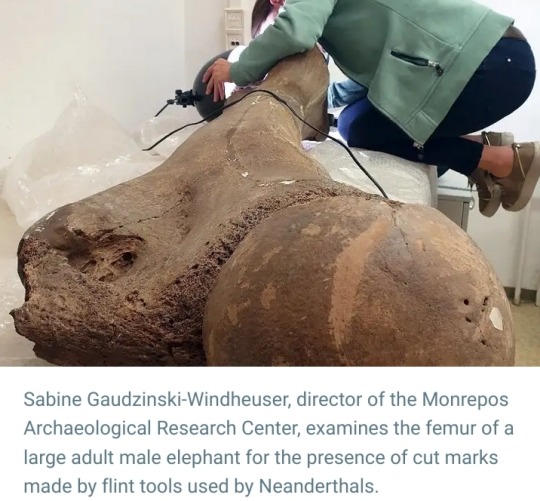
"Hunting these giant animals and completely butchering them was part of Neanderthal subsistence activities at this location," Wil Roebroeks, a co-author of the study, told AFP.
"This constitutes the first clear-cut evidence of elephant hunting in human evolution," said Roebroeks, a professor of archeology at Leiden University in the Netherlands.
The study suggests that the Neanderthals who lived in the area for 2,000 to 4,000 years were less mobile and formed social units "substantially larger than commonly envisaged."
"Neanderthals were not simple slaves of nature, original hippies living off the land," Roebroeks said.
"They were actually shaping their environment, by fire... and also by having a big impact on the biggest animals that were around in the world at that time."
'Calorie bombs'
The researchers determined the elephants had been hunted -- and not just scavenged -- because of the age and sex profile of the remains found in the quarry.
Most of them were males and there were few young or old ones.
"It's a typical selection made by hunters who went for the biggest prey," Roebroeks said.
Adult male elephants would have been easier to hunt than females, who tend to move in herds protecting their young.

"Whereas adult males are solitary animals most of the time," Roebroeks said. "So they are easier to immobilize, driving them into mud and pit traps.
"And they are the biggest calorie bombs that are walking around in these landscapes."
The researchers said the Neanderthals were able to preserve the huge quantities of food provided by a single elephant and it would sustain them for months.
"An average male elephant of about 10 tons would have yielded something like, minimally, 2,500 daily portions for an adult Neanderthal," Roebroeks said.
"They could deal with it, either by preserving it for longer time periods -- that is already something that we didn't know -- or simply by the fact that they lived in much, much larger groups than we commonly infer."
Cut marks
The researchers said the Neanderthals used flint tools to butcher the animals, which left clear traces on the well preserved bones.
"They are classical cut marks that are generated by cutting and scraping off the meat from the bones," Roebroeks said.
Traces of charcoal fires used by the Neanderthals were also found, suggesting they may have dried meat by hanging it on racks and building a fire underneath.
Roebroeks said that while the study provides evidence the Neanderthals lived in large social units, it is difficult to estimate exactly how large those groups actually were.
"But if you have a 10-ton elephant and you want to process that animal before it becomes rotten you need something like 20 people to finish it in a week," he said.

la-cl/dw
© Agence France-Presse
#Neanderthals#Science Advances#Halle#Germany#Pleistocene era#elephants#Wil Roebroeks#Sabine Gaudzinski-Windheuser
5 notes
·
View notes
Text
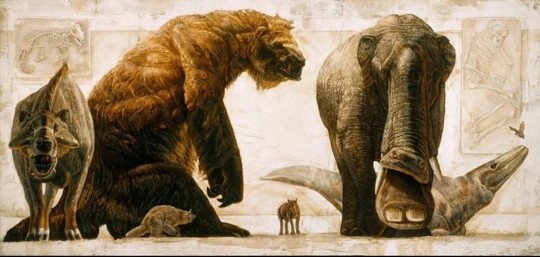
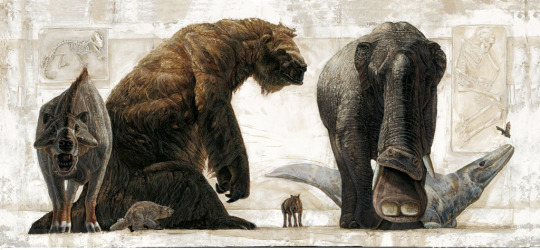
MAMMALS AS BIG AS HOUSES -- THESE DAYS WILL NEVER COME AGAIN.
PIC(S) INFO: Spotlight on a series of prehistoric creature illustrations demonstrating the evolution of mammals through the ages. More fact than fiction, these wild characters followed transitional Jurassic period animals that sported mammalian skull traits and reptilian teeth. A more familiar design, humans, mark the present. Artwork by Kennis and Kennis.
Didn't know which one I liked best, so, here's both of 'em. I just wish the resolution on either one was better than what they are: 1075x512 and 1024x475.
Source: www.nationalgeographic.com/science/article/rise-mammals.
#Mammals#Megafauna#Prehistory#Prehistoric Beasts#Prehistoric Animals#Prehistoric Creatures#Ground Sloth#Mega Mammals#Kennis and Kennis#History of Mammals#Ancient Animals#National Geographic#Pleistocene Era#Rise of Mammals#Prehistoric Elephants#Mammalian#Pleistocene#Prehistoric#Prehistoric Mega Mammals#Animals#Pleistocene Epoch#Pleistocene Mammals
1 note
·
View note
Text
they really named this guy big beast and thought we wouldnt notice

#megatherium#desiblr#je pense#paleontology#natural history#ancient#prehistory#mammals#coenozoic era#underrated#pleistocene#paleocene#biology#nature#naming#nomenclature#funny animals
6 notes
·
View notes
Text
The Rise of Mammals: an evolutionary tale of extinction and diversification

The above infographic is a brief summary. Mammals and dinosaurs evolved at the same time, but while the legendary asteroid killed off all the big-bodied dinosaurs, the herbivores and carnivores, the small, generalist mammals managed to survive on whatever's left (probably bones and ash lmao). 7% of the mammal species remained after the asteroid came down, and today, these mammals have diversified into three large groups: the eutherians, the monotremes, and the marsupials, with the eutherians reigning as the dominant group in this era.
Link to the full story here
#aslzoology#asl zoology#zoology articles#mammals#evolution#era of mammals#pleistocene#cretaceous#dinosaurs#evolutionary biology#archaeology#stem#stemblr#study#studyblr
7 notes
·
View notes
Text
encyclopedias are the ultimate autism enrichment because it's literally just a list of information
#encyclopedic volumes on a particular subject are even better#for example i own a paleontology book#in runs in chronological order from proterozoic to pleistocene and each era is sorted by plants/mammals/reptiles/other#its one of my top 5 favorite books i own#and i have an entire storage unit of just books
1 note
·
View note
Text
THERE WERE ELEPHANT SIZED GROUND SLOTHS???
#rot.txt#listen i love the pleistocene era but thats scary as shit. why were they so big!!!!!!!!!!!!!
0 notes
Text
Animal of the Day!
Great Auk (Pinguinus impennis)

(Photo from the Cincinnati Museum Center)
Extinction Date- 1844
Habitat- Northern Atlantic Ocean
Size (Weight/Length)- 75 cm
Diet- Fish; Crustaceans
Cool Facts- The great auk, while looking like a penguin, is nowhere close to being related to them. These seafaring birds were the only auk species to survive to the modern era, numbering in the millions during the Pleistocene. They were extremely powerful swimmers and the abundance of fish in the Northern Atlantic provided greatly. The great auk was held in high importance to Neolithic peoples due to their depiction in cave art and jewelry made of their bones. Unfortunately, great auks were easy to hunt and resulted in their extinction. Their feathers were used in pillows and their eggs were seen as a delicacy. The last pair of great auks were strangled to death and their egg was smashed in 1844. Today, the great auk’s closest relative is the razorbill. Luckily, the razorbill is of least concern with an increasing population due to protections placed on their fishing grounds.
Rating- 12/10 (In the genus Pinguinus, which penguins were later named after.)
#animal of the day#animals#auk#monday#monday 16#great auk#birds#sea birds#biology#science#conservation#the more you know#extinct#taxidermy#pleistocene#extinctober
294 notes
·
View notes
Text
On a secluded beach in Morocco, an extraordinary window into our past has been uncovered, revealing 85 human footprints that trace back to an astonishing 90,000 years ago. This remarkable find offers a unique glimpse into the lives of a group of Homo sapiens who walked the earth during the Late Pleistocene era.
85 notes
·
View notes
Text
“when they dig up your bones in 100 years they’ll know you’re a girl”
no no no no comrade. when palaeoarchaeology find fossilized pieces of my jaw bone and cranium and the remains of my iPhone in the bottom of a complex cave system in 47,000 years, they’ll have bigger things to debate than the sex of my remains. like. how did I get down there? why was I surrounded by pleistocene era animal remains? what the fuck was I making with those clay shards? what was the ritual importance of my Rolling Stones t-shirt? was I the victim of violence or did I fall and hit my head on every rock on the way down and is that why my skull is shattered into 73 distinct pieces?
509 notes
·
View notes
Text
Nel tardo Pleistocene, la popolazione umana era ridotta a un piccolo numero di coppie genitoriali, forse intorno a 1000 o poco più.
Se non fossero stati uomini e donne, ora non saremmo qui a discutere di omofobia e transfobia.
Fortunato Nardelli
77 notes
·
View notes
Text
"The imperative of protecting the vulnerable young in a predator-rich environment no doubt played a major role in shaping human sex differences and sexuality. La difference - the sexual dimorphism characteristic of humans and many other animals - is now believed to reflect, in large part, the greater role of males in actual combat with predators. Hunting, too, if it were a male-only activity, would have favored bigger, stronger males. But long before the male hunting band, males were probably deployed as baboon males are: to guard the periphery of the group." - Barbara Ehrenreich, Blood Rites.
Some years back I read a post about how war is basically an exercise in sending barely adult young men to kill each other, but this is made more palatable by honoring the young men used so. Blood Rites seems like basically an attempt to offer a theoretical model of the origins of that behavior; not so much the origins of the war part as the origins of the honoring part.
I've only read the parts I could find for free on the internet cause my local library doesn't seem to have the book and my financial situation is not great so I'm reluctant to buy it, I'm wondering if she talks more about how her theory relates to gender, especially masculinity, cause, like...
... Yeah, let's talk about those hypothetical proto-humans making their camp in the Pleistocene savanna, deploying in that gendered defensive formation, the fighting age adult males deployed in a ring at the periphery of the camp, clutching their sharpened sticks and stone hand axes (the mightiest human weapons of this era), deployed out there to watch for and defend against and absorb the violence of the savanna's predators, while the more vulnerable immature young and more demographically valuable females and the few elders who've managed to live long enough to become enfeebled get the relative safety of the camp's center.
If the masculine gender role originally emerged from that situation, I think that would explain a lot about what it looks like! In the context of that defensive formation might emerge association of maleness with combat and an idea that able-bodied adult males should participate in group violence, masculine protectiveness toward women and children and division of humanity into fighting men and protected ones (women, children, the old and disabled), valuing and honoring of courage in combat especially in males, shaming and ostracism and punishment of young males who very understandably show noticeable reluctance to leave the relative safety of the group's core and take a place in the peripheral defensive ring when they reach maturity, females using gifts, affection, and sex as ways to reward males who show willingness to put themselves at risk for the sake of the group, honoring of heroes (the male who drove a sharpened stick into the lioness's side), honoring of the memory of martyrs (the male who threw little stones at the dinofelis and drew its hunger and rage down upon him so it would kill him instead of a woman or a child).
There's a paragraph, like, right after that quote that speculates that human playful/social non-reproductive sexuality may have evolved in that context, which, yeah, if we're going to talk about the gendered aspect of this we should talk about some of the stuff I talked about here. When I first conceptualized the first sentence of my response to that quote the phrasing that bubbled into my mind was "barely legal adult," which, lol, "barely legal" is a porn category, usually meaning an 18 year old young actress IIRC, but actually I think there might be something in noticing that parallel, pulling on that thread! Also, I see a possible intersection with the Sex At Dawn kind of monogamy as a relatively recent innovation hypothesis in this. In this gendered anti-predator defense formation males would work together to defend the females and immature young of the group as a collectivity. If you're going to use male-female sexual bonding to strengthen that relationship, it would probably work better if it was polyamorous so most or all of the group's fighting males would feel that attraction-affection-gratitude-protectiveness tangle of emotions toward many of the group's females.
Re: hunting hypothesis vs. defense hypothesis for the origins of human organized violence, which is something Ms. Ehrenreich talks about (she's strongly on the side of the defense hypothesis) - as I pointed out here, I think the human tendency to honor courage is suggestive; courage is the virtue of a prey species that engages in collective defense; a smart predator attacks the weak, avoids fights with the strong, and quickly retreats if it loses the advantage. Then again, bravery is also useful in intra-species competition, so that's not conclusive (notably, I think the "a smart predator isn't brave" thing isn't so obvious to a lot of humans because present and recent historical human hunting is often partly an intra-species social activity oriented toward gaining prestige by killing big, strong, dangerous animals and taking impressive trophies). I also think that stuff like that visceral dislike of deserters David Graeber talked about fits better with this model. Like, yeah, I guess big game hunting might have been vital to survival sometimes, but it's hard to see "all men must be hunters!" as a strong imperative unless it's really about something else (like enforcing gender conformity). But an able-bodied adult male who runs away instead of defending the women and children when the hungry lions come? Yeah, I could see emotions that incline toward very strongly disincentivizing that behavior getting strongly selected for. Then again, the threat that encouraged strong negative attitudes toward deserters might have been organized violence by other human groups, we've had at least multiple millennia when the animal most likely to kill a human was another human, so again, not conclusive.
IDK though I'm probably biased toward this model cause it's extremely congruent with my kinks and damage lol. Like, one of my "maybe I'm an outlier and shouldn't be counted, but..." issues with 2010s flavor feminism was "if you're going to talk about masculinity, I'm a cis-in-the-expansive-sense male and I don't really see myself at all in this figure of the entitled misogynistic 'bro' you seem to think is the default state of men in our society, but I once ignored a severe and painful toe infection cause I just kind of didn't want to be a bother about it and didn't want to inflict a doctor's bill on my family, and something in my brain shivers in dark rapture at the 'I will stay and be thy husband / though it be the death of me' line in The Maiden and the Selkie."
Another thing I'm wondering about is if the book touches on the situation I talked about here and here, where early humans got smart enough to imagine pre-emptive self-defense with a long planning horizon and revenge and started to turn the tables and actively hunt human-eaters. Because if we're suggesting that the "put them in white robes and give them gold bands" aspect of war is originally derived from our responses to predation, that seems like it might have been a very important stage in the emergence of that!
There's a bit in the book speculating that the primordial situation religious sacrifice reconstructs is a group of proto-humans being attacked by a predator and one of them being killed and carried away, possibly with one of the proto-humans either voluntarily offering themselves to the predator so it doesn't hurt the others or being chosen as a designated victim (note: this was Barbara Ehrenreich relating somebody else's idea). And, yeah, I guess that might be a harrowing formative collective trauma of our species, but it doesn't leave much time for ceremony and it's an inherently unpredictable fast messy process. It really wouldn't be a promising nucleus for rituals to grow around. It might get associated grief rituals that happen afterward, but the kind of ceremonialization of war Barbara Ehrenreich is talking about is more about the preparation for organized violence, the build-up. Also, I think a big part of the emotional appeal of that ceremonialization of war is that it generates a feeling of power, whereas watching one of your friends get dragged away by a lion would have exactly the opposite effect, it would make you feel weak and afraid.
You know what would offer time for ceremony and a prolonged period of fearful-angry-mournful-but-also-hopeful emotional build-up? When some clever proto-humans get a bright idea. They already hunt small weak animals like monkeys (chimps do), they are already used to fighting their predators with simple weapons, they have already learned to track predators to some extent to better avoid them, now combine these skill sets! Instead of waiting for the predator to come to them again and have the fight on its terms and hope to just drive it off so everyone gets to live one more day, they can seek its trail, find its lair, fight it in circumstances of their choosing, kill it and the end the threat of it forever, invert the ancient relationship between its species and theirs, hunt the dinofelis or megantereon or whatever that predator is! Now give it maybe a few generations or centuries or millennia for that practice to become an institution...
Here is the opportunity for vows of revenge choked out through tears as what's left of the predator's latest victim is buried in honor. Here is the opportunity for the selection of champions. Here is the opportunity for rituals to prepare the chosen for their terrible and glorious task (dream image: an old woman opening a shallow cut on her left arm with an obsidian butchery flake and using a thumb to smear a little of her blood on the foreheads of five 16-26 year old boys). Here is the opportunity for the chosen to dance around the fire and sing confident war songs ("you big dumb cat, you don't know what's coming! You think we'll wait for you to come again and eat another of us like the dumb antelope! You'll be so surprised when we hunt you instead, when we trap you in your hole and kill you! I'll cut your stomach open to get my niece's bones back! I'll cut off your head and cut out the teeth you tore up my niece with and give them to my mother and my aunt to wear in their hair!"). Here is the opportunity for the community to luxuriate in the promise of power and deliverance their cleverness offers them (the big dumb cat indeed is oblivious to the danger it's in, no other prey species has the cognitive capacity for the kind of strategic thought these early humans are doing, this kind of prey behavior is an outside context problem its instincts do not prepare it for) and dream of a better future when the enemy is defeated. Here is the opportunity for the chosen to be indulgently pampered with food, affection, and sex as a reward for their selflessness, with the promise that they will be given more of the same treatment if they come back from their great task victorious and their memory will be honored if they die during their mission.
Imagine the high that might be for a prey species, especially if they still remember the long age of fear and grief and impotent anger before they realized they could turn the tables, hunt the hunter. Something something that Frantz Fanon-ish therapeutic value of inflicting violence on your tormentor idea.
“One of the most dangerous things in the universe is an ignorant people with real grievances. That is nowhere near as dangerous, however, as an informed and intelligent society with grievances. The damage that vengeful intelligence can wreak, you cannot even imagine.” - Frank Herbert, Heretics of Dune.
Aside: I know some nonhuman animals do sometimes attack their predators pro-actively, e.g. I've heard about cape buffalo doing that, but I don't think they do anything like try to systematically exterminate every individual predator that attacks a member of their group including tracking them and hunting them down with days-to-weeks planning horizons; you'd need some pretty serious cognitive capacity for that kind of strategic thought which I don't think cape buffalo and the like have.
In a different corner of Tumblr somebody made a post arguing that it's absurd to think that men experience gender oppression qua being men because there's no uniquely male experience of oppression. It's not an argument I particularly want to get into, but I think what I've just written is kind of a counter-argument against that idea, though admittedly a very weak one; highly speculative, and Anglophone internet feminists are usually talking centrally about relatively peaceful societies where being a man isn't particularly dangerous, and societies where being a man is dangerous are often really dangerous for women too.
#Barbara Ehrenreich's Blood Rites#gender#my big ideas#human evolution#i don't know what to tag this#warning: long
44 notes
·
View notes
Note
Can you recommend any dinosaur themed video games? Or maybe games that just have evolution somehow play a part?
sO
for one, you can always play Evolution! evolution is a video game based on a card game that is actually a pretty great game-ification of the process of evolution (I have a couple of big critiques - predators don't hunt their prey into extinction as a general rule, but that's a key game component) and fun to play
if you're cool with going retro, the game Spore is essentially an evolution simulation game, even if its a bit oversimplified
The game Ecosystem mimics evolution too, you essentially are creating an underwater ecosystem from scratch, but my immersion is broken by the modern-type plants juxtaposed with cambrian-era fish
ironically, games with prehistoric life and games about evolution? not the same two things. none of those games really feature actual prehistoric life.
But, there are games that do!
I actually really like Saurian. It's still in alpha, and has a lot of development to do, but it's essentially a complete recreation of Hell Creek, and you can grow up as a raptor or as a triceratops!
Then there's Prehistoric Kingdom, which is a park builder sim with prehistoric life. The online community for it sucks (major transphobia incident), but the game itself is a fun time, and the dinosaurs are gorgeous.
I also enjoy Jurassic World Evolution 2. Sure, JW is inaccurate af, and every time I see manual unguals on digits 4 and 5 on the hands/front feet I scream internally, but a) there are lots of accuracy mods and b) the graphics are gorgeous
Let's Build a Zoo has prehistoric life, too! And things you wouldn't expect! It's kind of a basic game, but it's fun. And has more birds than fucking planet zoo does.
Zoo Tycoon 2 is still probably the best zoo game around, somehow, and there are tons of mods to add virtually as many prehistoric animals as you want. Hell, my friends and I made a Kulindadromeus mod for it! Literally! Any dinos you want.
Roots of Pacha is a game similar to Stardew that takes place in the Pleistocene! It's all about the power of human cooperation and community building, complete with Mammoths and Smilodon and Glyptodonts. Its a fun game, and I love it a lot. Can't wait for it to update more!
Dawn of Man is a pretty good caveman sim, as well, but it's very realism-focused, and killing mammoths is part of the game, so it's a bummer. But it's fun to go through the history of stone age human technology.
Dinosaur Fossil Hunter is... meh. the protagonist is a muscular white guy. the adventure side of paleontology is overemphasized. the controls are kind of crappy. I can't recommend it.
Tyto Ecology is a fun, if basic, ecology simulator, but it is no longer being developed or supported. Still, I enjoyed it.
aaaand... those are my recommendations. The pickings are kind of slim. Hence my desperate desire to make more prehistoric life and evolution themed games!
that said, keep an eye out - Paleopines and Super Zoo Story are both coming out soon, and they both have dinosaurs!
99 notes
·
View notes
Text
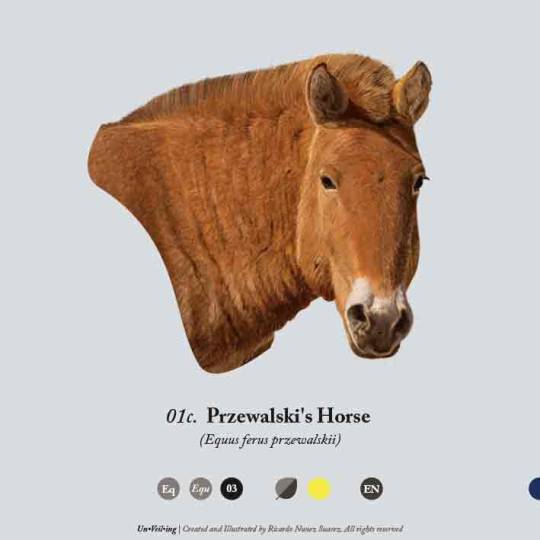
Przewalski's Horse
Equus ferus przewalskii
Family: Equidae
Genus: Equus
Subspecies: 03
Feed: Herbivorous
Habitat: Temperate Steppe
Status and Conservation: Critically Endangered
This is the only remaining species of wild horse. The other two wild horse species have already become extinct. One of them is the Tarpan (which was mentioned in a previous post), and the other is the European Wild Horse, which went extinct during the Pleistocene era. The other horses that roam in the wild are considered feral, which means they were once domesticated horses that have reverted to a wild state.
The Przewalski Horse was also extinct in the wild at one point. However, thanks to various breeding programs and the efforts of different zoos, it has been successfully reintroduced to its natural habitat in Mongolia and China. It is still classified as Critically Endangered."
________________________________
Credits:
Handbook of The Mammals of the World. Hoofed Animals.
________________________________
Thank you for being here. Likes, reblogs, and follows are very much appreciated. See you next week with more mammals. A new family to show! Huuuuuuuuu
#przewalski's horse#horse#caballo#love horses#horse lover#wild horse#feral horse#illustration#drawing#scientific illustration#illo#wild animals#wildlife#animals#artist on tumblr#mammals#animal#critically endangered#inforgraphics
75 notes
·
View notes
Text

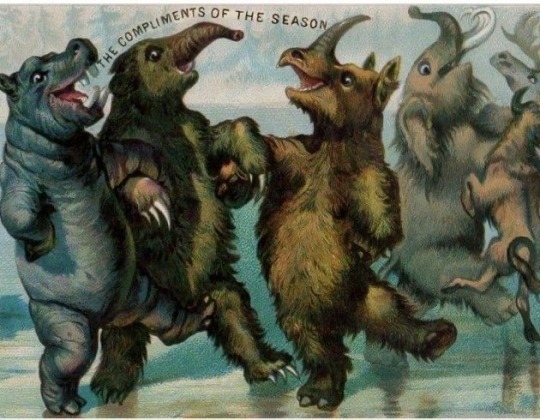
victorian era christmas cards featuring pleistocene megafauna by the de la rue company for the natural history museum of london
#victorian#vintage christmas#natural history museum#london#pleistocene#megafauna#antiques#paleontology#upl
15 notes
·
View notes
Text
People stop saying 'paleolithic' when you mean 'pleistocene' challenge
'Paleolithic' is a HUMAN CULTURAL era!!! Sabre tooth cats are not Paleolithic. Mammoths aren't Paleolithic except in the context of their relationship to humans.
Paleolithic means 'old stone age' specifically referring to the creation of stone tools by humans [and distinct from the neolithic, new stone age, by the foraging lifeway vs neolithic being more agricultural]. It's the equivalent of using 'Victorian era' to talk about China, it's totally irrelevant
48 notes
·
View notes